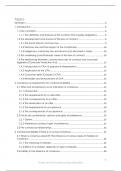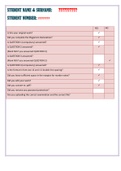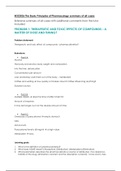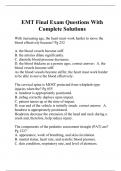2A1 Vector Algebra and Calculus
8 Lectures MT 2013 Stephen Roberts
Rev Oct 2013
Course Page www.robots.ox.ac.uk/∼sjrob/Teaching/Vectors
Overview
Many of you will know a good deal already about Vector Algebra — how to add and subtract
vectors, how to take scalar and vector products of vectors, and something of how to describe
geometric and physical entities using vectors. This course will remind you about that good stuff,
but goes on to introduce you to the subject of Vector Calculus which, like it says on the can,
combines vector algebra with calculus.
To give you a feeling for the issues, suppose you were interested in the temperature T of water in
a river. Temperature T is a scalar, and will certainly be a function of a position vector x = (x , y , z )
and may also be a function of time t: T = T (x, t). It is a scalar field.
Suppose now that you kept y , z , t constant, and asked what is the change in temperature as you
move a small amount in x ? No doubt you’d be interested in calculating ∂T /∂x. Similarly if you
kept the point fixed, and asked how does the temperature change of time, you would be interested
in ∂T /∂t.
But why restrict ourselves to movements up-down, left-right, etc? Suppose you wanted to know
what the change in temperature along an arbitrary direction. You would be interested in
∂T
,
∂x
but how would you calculate that? Is ∂T /∂x a vector or a scalar?
Now let’s dive into the flow. At each point x in the stream, at each time t, there will be a stream
velocity v(x, t). The local stream velocity can be viewed directly using modern techniques such
as laser Doppler anemometry, or traditional techniques such as throwing twigs in. The point now
is that v is a function that has the same four input variables as temperature did, but its output
result is a vector. We may be interested in places x where the stream suddenly accelerates, or
vortices where the stream curls around dangerously. That is, we will be interested in finding the
acceleration of the stream, the gradient of its velocity. We may be interested in the magnitude of
the acceleration (a scalar). Equally, we may be interested in the acceleration as a vector, so that
we can apply Newton’s law and figure out the force.
This is the stuff of vector calculus.
,2
Grey book
Vector algebra: scalar and vector products; scalar and vector triple products; geometric appli-
cations. Differentiation of a vector function; scalar and vector fields. Gradient, divergence and
curl - definitions and physical interpretations; product formulae; curvilinear coordinates. Gauss’
and Stokes’ theorems and evaluation of integrals over lines, surfaces and volumes. Derivation
of continuity equations and Laplace’s equation in Cartesian, cylindrical and spherical coordinate
systems.
Course Content
• Introduction and revision of elementary concepts, scalar product, vector product.
• Triple products, multiple products, applications to geometry.
• Differentiation and integration of vector functions of a single variable.
• Curvilinear coordinate systems. Line, surface and volume integrals.
• Vector operators.
• Vector Identities.
• Gauss’ and Stokes’ Theorems.
• Engineering Applications.
Learning Outcomes
You should be comfortable with expressing systems (especially those in 2 and 3 dimensions) using
vector quantities and manipulating these vectors without necessarily going back to some underlying
coordinates.
You should have a sound grasp of the concept of a vector field, and be able to link this idea to
descriptions of various physical phenomena.
You should have a good intuition of the physical meaning of the various vector calculus operators
and the important related theorems. You should be able to interpret the formulae describing
physical systems in terms of this intuition.
References
Although these notes cover the material you need to know you should, wider reading is essen-
tial. Different explanations and different diagrams in books will give you the perspective to glue
everything together, and further worked examples give you the confidence to tackle the tute sheets.
• J Heading, ”Mathematical Methods in Science and Engineering”, 2nd ed., Ch.13, (Arnold).
• G Stephenson, ”Mathematical Methods for Science Students”, 2nd ed., Ch.19, (Longman).
• E Kreyszig, ”Advanced Engineering Mathematics”, 6th ed., Ch.6, (Wiley).
• K F Riley, M. P. Hobson and S. J. Bence, ”Mathematical Methods for the Physics and
Engineering” Chs.6, 8 and 9, (CUP).
• A J M Spencer, et. al. ”Engineering Mathematics”, Vol.1, Ch.6, (Van Nostrand Reinhold).
• H M Schey, “Div, Grad, Curl and all that”, Norton
, 3
Course WWW Pages
Pdf copies of these notes (including larger print versions), tutorial sheets, FAQs etc will be accessible
from
www.robots.ox.ac.uk/∼sjrob/Teaching/Vectors
, 4










